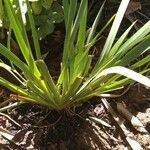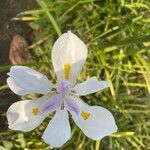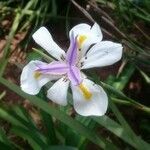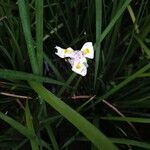Perennial herb, 0.75-1.00 m high; stem irregularly branching. Leaves linear. Bracts entirely sheathing; apices obtuse or apiculate. Spathe 50-80 mm long, apex obtuse or emarginate, margins free to base. Flowers white; nectar guides yellow; limbs horizontal to recurving; outer tepals with dense yellow beard on midline; inner tepals with dark brown markings. Stamens with tapering filaments, contiguous at base; anthers 7-10 mm long. Style 5 mm long, with pale mauve branches. Flowering time Sept.-Mar. Capsule 28-50 mm long, cylindrical, ridged and furrowed vertically, splitting into 3 locules when mature.
Pending.




